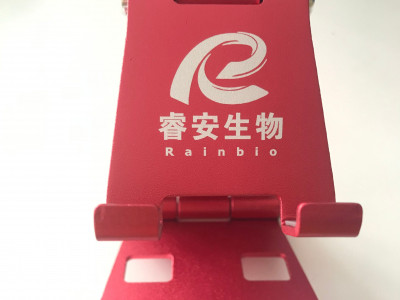细胞名称:人脐带间充质干细胞(hUMSC)
细胞形态图:
细胞来源:人,脐带。
细胞简介:
hUMSC是经典的间充质干细胞类型,具有自我更新能力和多向分化潜能。 细胞在传统培养方式下贴壁生长,细胞呈梭形,整体分布呈漩涡状。表达CD45、CD73、CD90、CD105、CD166,不表达CD11b、CD34、HLA-DR。具有分化为成骨细胞、脂肪细胞、成软骨细胞的能力。
Cell Specification
Mesenchymal stem cells (MSC) are a well-characterized population of adult stem cells. MSC
have the potential to develop into mature cells that produce fat, cartilage, bone, tendons, and
muscle. These properties, in combination with their developmental plasticity, have generated
tremendous interest because of the potential use of MSC in regenerative medicine. MSC isolated
from the Wharton’s jelly of the umbilical cord were induced to transform into neurons and glia in
vitro by using neuron-conditioned medium, sonic hedgehog, and FGF-8 [1, 2]. MSC can also
differentiate into cells from the adipogenic and osteogenic lineage. Additionally, they have the
potential to differentiate into cardiomyocytes by culturing them in cardiomyocyte-conditioned
medium [3]. MSC express the matrix receptors CD44 and CD105 and mesenchymal stem cell
markers SH2 and SH3, but not the hematopoietic lineage marker CD34.
HUMSC from ScienCell Research Laboratories are isolated from Wharton’s jelly of the
umbilical cord. HUMSC are cryopreserved at passage one and delivered frozen. Each vial
contains >5 x 105
cells in 1 ml volume. HUMSC are characterized by immunofluorescence with
antibodies specific to CD73 and/or CD90, Oil Red O staining after adipogenic differentiation,
and Alizarin Red staining after osteogenic differentiation. HUMSC are negative for HIV-1,
HBV, HCV, mycoplasma, bacteria, yeast and fungi. HUMSC are guaranteed to further expand
for 15 population doublings under the conditions provided by ScienCell Research Laboratories.
Recommended Medium
It is recommended to use Mesenchymal Stem Cell Medium (MSCM, Cat. #7501) for culturing
HUMSC in vitro.
Product Use
HUMSC are for research use only. They are not approved for human or animal use, or for
application in in vitro diagnostic procedures.
Storage
Upon receiving, directly and immediately transfer the cells from dry ice to liquid nitrogen and
keep the cells in liquid nitrogen until they are needed for experiments.
Shipping
Dry ice.
References
[1] Mitchell KE, Weiss ML, Mitchell BM, Martin P, Davis D, Morales L, Helwig B, Beerenstrauch M, Abou-Easa
K, Hildreth T, Troyer D, Medicetty S. (2003) “Matrix cells from Wharton’s jelly form neurons and glia.” Stem Cells
21: 50-60.
[2] Fu YS, Cheng YC, Lin MY, Cheng H, Chu PM, Chou SC, Shih YH, Ko MH, Sung MS. (2006) “Conversion of
human umbilical cord mesenchymal stem cells in Wharton’s jelly to dopaminergic neurons in vitro: potential
therapeutic application for Parkinsonism.” Stem Cells 24: 115-124.
[3] Wang HS, Hung SC, Peng ST, Huang CC, Wei HM, Guo YJ, Fu YS, Lai MC, Chen CC. (2004) “Mesenchymal
stem cells in the Wharton’s jelly of the human umbilical cord.” Stem cells 22: 1330-1337.
Ver. 1
Instructions for culturing primary cells
Caution: Cryopreserved primary cells are very delicate. Thaw the vial in a 37oC water
bath and return the cells to culture as quickly as possible with minimal
handling! Do not centrifuge the cells after thawing as this can damage the cells.
Initiating the culture:
Note: ScienCell primary cells must be cultured in a 37oC, 5% CO2 incubator. Cells are only
warranted if ScienCell media and reagents are used and the recommended protocols are
followed.
1. Prepare a fibronectin-coated culture vessel (2 μg/cm2
, T-75 flask is recommended). To
obtain a 2 μg/cm2
fibronectin-coated culture vessel, add 10 ml of sterile Dulbecco’s
phosphate buffered saline, Ca++
- and Mg++
-free (Cat. #0303) to a T-75 flask and then add
150 μl of fibronectin stock solution (Cat. #8248). Leave vessel in a 37oC incubator
overnight (or for at least 2 hours).
2. Prepare complete medium. Decontaminate the external surfaces of medium bottle and
medium supplement tubes with 70% ethanol and transfer them to a sterile field.
Aseptically transfer supplement to the basal medium with a pipette. Rinse the supplement
tube with medium to recover the entire volume.
3. Aspirate the fibronectin solution and add 20 ml of complete medium to the culture vessel.
The fibronectin solution can be reused twice. Leave the vessel in the sterile field and
proceed to thaw the cryopreserved cells.
4. Place the frozen vial in a 37oC water bath. Hold and rotate the vial gently until the
contents completely thaw. Promptly remove the vial from the water bath, wipe it down
with 70% ethanol, and transfer it to the sterile field.
5. Carefully remove the cap without touching the interior threads. Gently resuspend and
dispense the contents of the vial into the equilibrated, fibronectin-coated culture vessel.
Note: Dilution and centrifugation of cells after thawing are not recommended as these
actions are more harmful to the cells than the effect of residual DMSO in the culture.
It is also important that cells are plated in fibronectin-coated culture vessels to promote
cell attachment.
6. Replace the cap or lid of the culture vessel and gently rock the vessel to distribute the
cells evenly. Loosen cap, if necessary, to allow gas exchange.
7. Return the culture vessel to the incubator.
8. Do not disturb the culture for at least 16 hours after the culture has been initiated. Refresh
culture medium the next day to remove residual DMSO and unattached cells.
Maintaining the culture:
1. Change the medium every 2 to 3 days thereafter, until the culture is approximately 70%
confluent.
2. Once the culture reaches 70% confluency, change medium every other day until the
culture is approximately 90% confluent.
Ver. 1
Subculturing:
1. Subculture when the culture reaches 90% confluency.
2. Prepare fibronectin-coated culture vessels (2 μg/cm2
) one day before subculture.
3. Warm complete medium, trypsin/EDTA solution, 0.05% (T/E, Cat. #0183), T/E
neutralization solution (TNS, Cat. #0113), and DPBS (Ca++
- and Mg++
-free, Cat. #0303)
to room temperature. We do not recommend warming reagents and medium in a 37oC
water bath prior to use.
4. Rinse the cells with DPBS.
5. Add 5 ml DPBS and 5 ml 0.05% T/E solution (Cat. #0183) into flask (in the case of a T75 flask). Gently rock the flask to ensure complete coverage of cells by T/E solution. Use
a microscope to monitor the change in cell morphology.
Note: We recommend using ScienCell 0.05% T/E solution which is optimized to
minimize cell damage due to over trypsinization. If 0.25% T/E solution (Cat. #0103) is
used, then 9 ml of DPBS and 1 ml of 0.25% T/E solution should be used.
Caution: Do NOT use undiluted trypsin when subculturing primary cells.
6. During incubation, prepare a 50 ml conical centrifuge tube with 5 ml of fetal bovine
serum (FBS, Cat. #0500).
7. Once the cells completely round up, transfer T/E solution from the flask to a 50 ml
centrifuge tube (a small percent of cells may detach) and continue to incubate the flask at
37oC for another minute (no solution in the flask at this time).
8. At the end of incubation, gently tap the side of the flask to dislodge cells from the
surface. Check under a microscope to make sure that all cells detach.
9. Add 5 ml of TNS solution to the flask and transfer detached cells to the 50 ml centrifuge
tube. Rinse the flask with another 5 ml of TNS to collect the residual cells.
10. Examine the flask under a microscope for a successful cell harvest by looking at the
number of cells being left behind; there should be less than 5%.
11. Centrifuge the 50 ml centrifuge tube at 1000 rpm for 5 minutes. Gently resuspend cells in
culture medium.
12. Count and plate cells in a new fibronectin-coated culture vessel with the recommended
cell density. A seeding density of 5,000 cells/cm2
is recommended.
Note: We do not recommend cryopreservation of primary cells by the end user.
Refreezing cells may damage them and affect cell performance. ScienCell does not
guarantee primary cells cryopreserved by the end user.
Caution: Handling human derived products is potentially biohazardous. Although each cell strain tests negative
for HIV, HBV and HCV DNA, diagnostic tests are not necessarily 100% accurate, therefore, proper
precautions must be taken to avoid inadvertent exposure. Always wear gloves and safety glasses when working
with these materials. Never mouth pipette. We recommend following the universal procedures for handling
products of human origin as the minimum precaution against contamination [1].
[1] Grizzle WE, Polt S. (1988) “Guidelines to avoid personal contamination by infective agents in research
laboratories that use human tissues.” J Tissue Cult Methods. 11: 191‐9.



